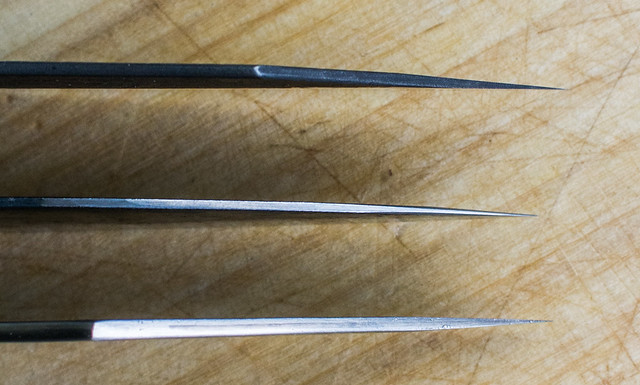OK, this one is due since quite a while and I am using now the time in bed (being struck down by some bug again) to catch up on my plans.
The main motivation here is to try to compare 3 knives that share certain similarities (size, height, purpose), but all 3 are rather different when it comes to details and I though that some may find it interesting or even helpful.
As usually this is going to be a long read
A little bit of history
When I joined the world of high end kitchen knives it did not take me long to come across Murray Carter knives. I was in particular attracted by his kurouchi knives for their unique design and after few months of lurking I got that offer (I think it was called "You're the boss" - one could offer a price for a certain knife and if reasonable you could get the knife for less than listed price). At that time it was hard to get a kurouchi Carter as these usually sold out within hours. But I dropped them an email and got lucky - they just had a batch of KU knives and so I could pick one before these were posted. And since I could actually name the price - I got the knife for a whooping $280.
The Yoshikane caught my eye when I was browsing epicedge webpage - I quickly realised that the shape could be very practical - flat-ish profile, pointy tip and strongly front-forward center of mass. I finally pulled the trigger and was not disappointed. I have lent the knife to my friend and knife-soulmate and soon he ordered one too.
The Kochi. I was intrigued by this series since a while - thin behind the edge, but on the workhorse side weight-wise. I was just lacking the excuse to buy one (I already had my Billipp gyuto a that point, so getting another gyuto was not an option). But when I was making a large order from Jon (a 'collective' order to save on shipping) I could not resist and ordered the Santoku.
So - here are the knives
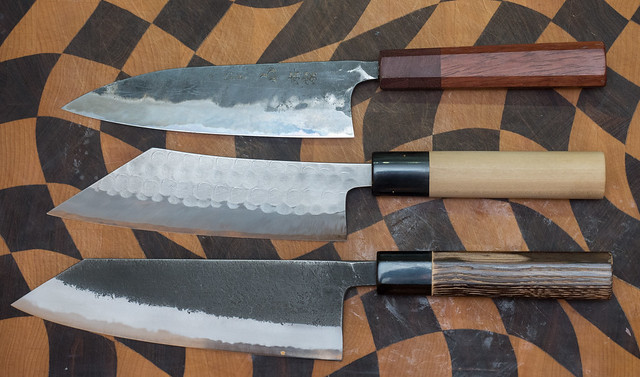
Some specifications
Carter
Blade length:165mm
Blade height: 43 mm
Weight:110 g
Spine thickness of 1 mm: 16 mm from the tip
Position of the CoM: at the heel
Yoshikane
Blade length:167mm
Blade height: 44 mm
Weight:144 g
Spine thickness of 1 mm: 12 mm from the tip
Position of the CoM: 22 from the heel
Kochi
Blade length:180mm
Blade height: 55 mm
Weight: 146 g
Spine thickness of 1mm: 15 from the tip
Position of the CoM: 20 mm from the heel.
CoM stands for Center of Mass
As you can see - the Yoshikane and the Kochi weight about the same, but the Carter is considerably lighter. That of course also impacts the weight distribution and feel in hand. The Yoshikane feels like a little cleaver - makes you want to chop stuff (and it does that very well) - a guillotine for vegetables. The Kochi is also a good chopper with front-forward weight distribution, but feels less 'extreme' compare to the Hakata and has less weight on the tip. The reason for this difference is not the position of the CoM (which is virtually identical to Yoshikane), but the weight distribution along the blade which is more extreme with the Yoshikane. The Carter has neutral weight distribution and feesl balanced with a pinch grip and has effectively 0 weight on the tip. This makes it feel more as a slicer. Of course it can chop, but the feel is different. The difference among the knives in this regards becomes more obvious when you use the tip to trip ends from green beens - Kochi or Yoshikane allow you basically just drop the tip of the knife, the Carter requires more active cut / push-down motion.
Since that I recently got a digital calliper I took the time to measure the thickness of the blades. I decided on 2 positions - 50mm form the heel and 50mm from the tip. The numerical precision of the calliper is 0.01mm, but realistically with hold din the blade in hands the precision would be closer to 0.02 - 0.03mm.
Here are the measured data
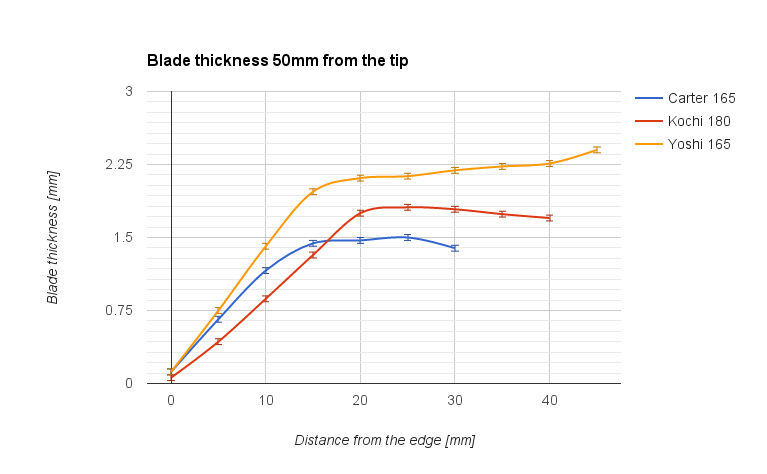

Let's have a look at some choil shots
Left to right: Kochi, Yoshikane, Carter
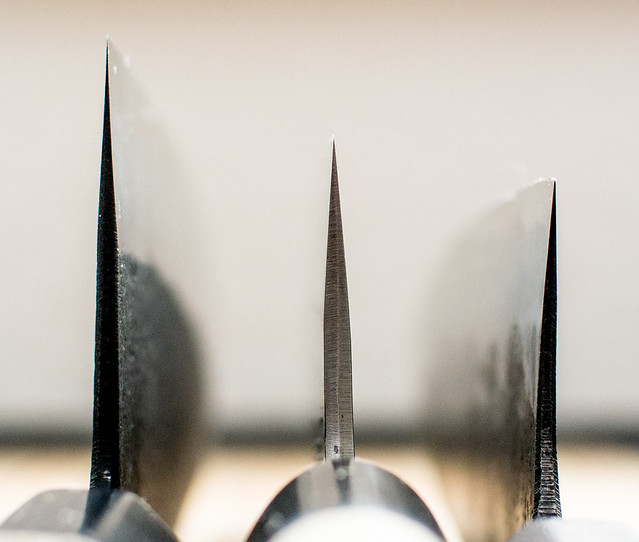
Blade geometry & cutting properties
Here is where the things get interesting. Apart from the obvious differences in the the tip & spine shape, the profile of the cutting edge is relatively similar among these 3 knives. But the grind shows differences that also impact how the knives cut.
Let me start with the Carter. At this stage I should mention, that the knife was thinned (up to kurouchi line) by Greg from Wabocho and is now indeed very thin. The blade geometry was kept and it is a more-less continuous convex grind that does not have 'shoulders' (not quite true if you look at the graphs above, they are there, but much less pronounced). This makes the blade to be a very good slicer with not too great food release. But cutting hard vegetables works great and that is also what I use the knife for rather often.
The Kochi and Yoshikane are both a wide bevel design, but the bevel is wider and thinner on the Kochi. Another difference is that while the bevel on the Yoshikane is for all practical purposes flat (and I maintain that geometry when sharpening), the grind of the bevel on Kochi is ever so slightly concave (I asked Jon about is and his answer was: "Its not so much intentional as it is a function of the tools being used to make the knife"), what makes the blade (when new) incredibly thin behind the edge. I have so far sharpened the Kochi only on edge, but once some more material will be removed I will probably start to sharpen it like the Yoshikane - the whole bevel (flat) and apply a microbevel.
The Yoshikane does great on Onions and other semi-hard stuff where the not-that-thin wide bevel can push the food away from the knife and there is very little drag. This also means that cutting a thick carrot is not quite as enjoyable as with the Carter. The tip on the Yoshikane is very thin and very useful, but needs to be used with care. Food release is relatively good.
Kochi in certain ways combines the properties of the Carter and Yoshikane. The grind is thin, so the knife does not protest when cutting hard vegetables and with larger items the food release is quite good. What does show a bit is the fact, that the bevel is (ever so slightly) concave - that makes some items stuck a little more than they would on the Yoshikane.
One short comment on the blade height. The Carter and Yoshikane are basically the same, but the Kochi is considerably taller. The upside with the Kochi is that you do not get into contact with what you are cutting so fast what makes the blade effectively a little longer at times. But I did notice that it takes me more care to get the same precision when chopping than with the Yoshikane - simply because your hand is further away from the cutting board. I am sure that more practice (I do not have the Kochi that long) will take care of that, but I thought I would mention it.
Edge properties
When it comes to edge holding than it is probably not going to be a surprise that the Yoshikane lasts the longest - by a long stretch. First of all - the Steel contains 5.5% Chromium, 0.5% Vanadium plus some more alloys and is hardened to about HRC64. The Kochi has V2 cutting edge and the Carter white#1 and both are fairly comparable in this regard and since these steels are low alloy steels they are not going to beat more complex steels in the edge holding department. For me these differences do not play much of a role as when a knife stops biting as I would like it to, I can quickly touch the blade up on my Gesshin Synthetic Natural stone (ma favourite finisher as of recently) - in particular easy to do with low alloy carbon steels.
Edge stability looks very differently. The downside of the Yoshikane and its very high hardness is brittleness. Even though it does not have quite as acute wide bevel angle as the Kochi, it micro-chips easily. Using a micro bevel is a must and even then I will get some slight microchipping (remember - this knife sees a lot of chopping) between sharpening. It does not bother me as it is really little and goes away with every sharpening sessions, but one needs to be very careful not to stab anything hard (e.g. the cutting board) with the very thin tip. The Kochi and Carter also do get an asymmetric microbevel (all my kitchen knives have one), but microchipping under normal conditions just does not happen, even though the edges are thinner than on the Yoshikane.
Blade finish
As you can see in the photo - all 3 blades have quite different finish. Kochi has that yummy 3D-like kurouchi which I simply adore. The only other knife with similar kurouchi that I have seen until now is an Itinomonn that my friend has. Yoshikane has that hammered finish that to be honest does not look all that great online, but looking close up it has much more charm. Carter has that thin, flat kurouchi finish which is more resistant that I would have expected. It is not as attractive as the one on Kochi and since the whole knife is so thin it got removed partially when the bevels were ground. Still - it looks nice close-up and does help to keep rust off the blade.
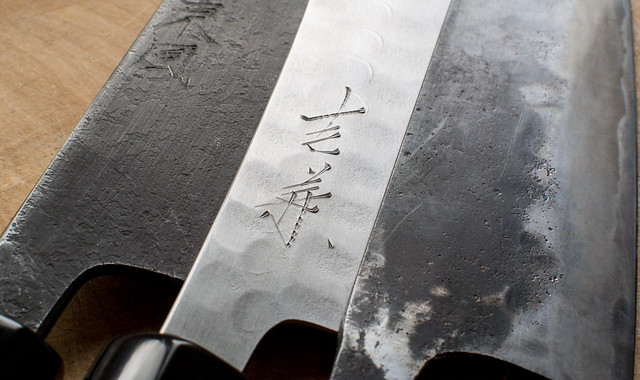
Bevels & patina
The Kochi is the only knife here that still has its original finish (which is very nice Kasumi). The bevels were finished to rather high grit (I guess), though not mirror polished. Interestingly - the blade took patina only slowly and it is not that wild collection of patches and streaks one often sees. The patina was (is) setting slowly. You can seen that as the blade towards the heel did not see as much acidic juices as the rest, that the patina did not fully form there yet. Yoshikane shows that I am not too patient when I sharpen the whole bevel (which I do with every sharpening) - I take it to JNS300, Gesshin 2000 (raise burr every time) and only finish it briefly on higher grit stone. I do not pay overly too much attention to the resulting finish, so you can see some scratch pattern from the corse stone. The strange patch towards the tip is actually from the gaffer's tape that I used as a gauge for the measurement of the thickness. Finally Carter - the finish you see here was done by Greg who finished the knife up to Takashima (plus with finger stones made from Takashima) and it is a great improvement over the rather coarse finish directly from Carter (water stone wheel I suppose). It takes a rather wild patina and does so relatively fast. Apart form the heel the patina is already settled.
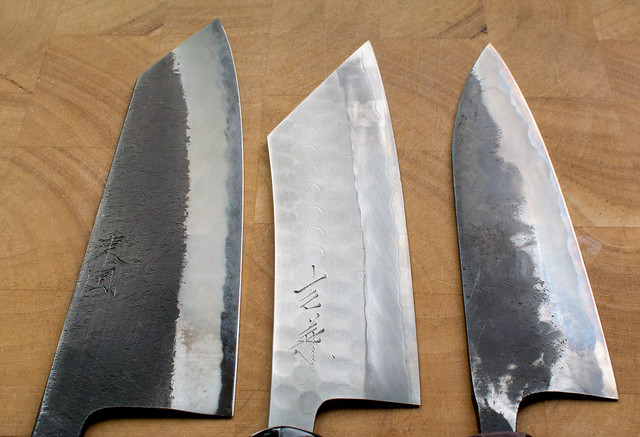
Blade reactivity
Obviously - the Yoshikane being stainless clad SKD (A2) has little potential for patina or rust. The SKD core will get some light patina with use, but you will never experience browning on onions or something like that. The Kochi and Carter strike me as similarly reactive - with both you will get browning of onions before some patina settles. The Carter seems to take visually dominant patina faster, while with Kochi the patina develops slower and is more homogeneous. Carter can take a bit unpleasant color with certain vegetables, the Kochi tends more towards blue-grey with the same food.
Few words about the handles
All 3 handles are 'original' (i.e. as they came from shop). Kochi has that nice and warm burned chestnut. I really like this material - it feels great in hand and optically it really fits the knife. It also has good size for the knife. Yoshikane has a D-shape ho-wood handle. I was not too crazy about it, it needs some light sanding over first few months, but now it settled and actually feels pretty nice. The point is to give it a light coat with board butter here and then - that keeps dirt from soaking into the wood. The handle on the Carter is combination of red and purple hard wood and it really is nicely done. It is on the subtle side - but suits the very lightweight knife very well and allows for good balance. More fancy handle would cause the knife to be butt-heavy. It feels really nice in hand, has excellent F&F and is very stable over time. I like it a lot.
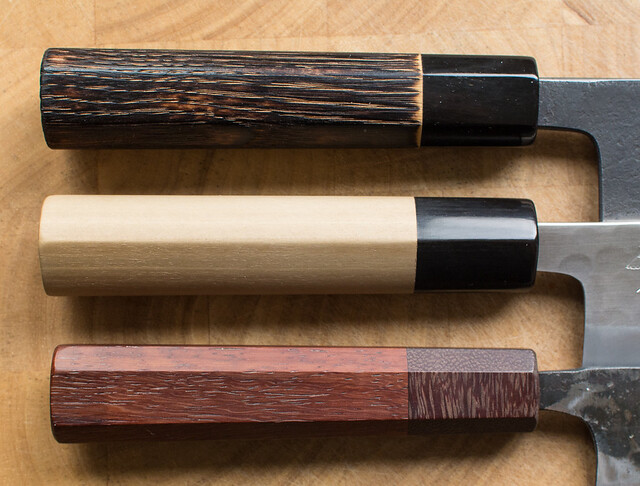
Summary
Since this a review and not a competition, there are no winners and no losers The Hakata has incredible edge holding, is a great chopped, but need to be sharpened such that you keep the microchipping at bay. Carter is a feather light go-through-everything knife - it feels the most universal from the bunch. It is still one of my favourite knives. Kochi is the knife to deal with very vegetables - my go-to knife for salad preparation. It has the right balance for chopping the additional blade height allows you to use the whole blade length.
The Hakata has incredible edge holding, is a great chopped, but need to be sharpened such that you keep the microchipping at bay. Carter is a feather light go-through-everything knife - it feels the most universal from the bunch. It is still one of my favourite knives. Kochi is the knife to deal with very vegetables - my go-to knife for salad preparation. It has the right balance for chopping the additional blade height allows you to use the whole blade length.
So - any questions left?
thank you for reading
The main motivation here is to try to compare 3 knives that share certain similarities (size, height, purpose), but all 3 are rather different when it comes to details and I though that some may find it interesting or even helpful.
As usually this is going to be a long read
A little bit of history
When I joined the world of high end kitchen knives it did not take me long to come across Murray Carter knives. I was in particular attracted by his kurouchi knives for their unique design and after few months of lurking I got that offer (I think it was called "You're the boss" - one could offer a price for a certain knife and if reasonable you could get the knife for less than listed price). At that time it was hard to get a kurouchi Carter as these usually sold out within hours. But I dropped them an email and got lucky - they just had a batch of KU knives and so I could pick one before these were posted. And since I could actually name the price - I got the knife for a whooping $280.
The Yoshikane caught my eye when I was browsing epicedge webpage - I quickly realised that the shape could be very practical - flat-ish profile, pointy tip and strongly front-forward center of mass. I finally pulled the trigger and was not disappointed. I have lent the knife to my friend and knife-soulmate and soon he ordered one too.
The Kochi. I was intrigued by this series since a while - thin behind the edge, but on the workhorse side weight-wise. I was just lacking the excuse to buy one (I already had my Billipp gyuto a that point, so getting another gyuto was not an option). But when I was making a large order from Jon (a 'collective' order to save on shipping) I could not resist and ordered the Santoku.
So - here are the knives

Some specifications
Carter
Blade length:165mm
Blade height: 43 mm
Weight:110 g
Spine thickness of 1 mm: 16 mm from the tip
Position of the CoM: at the heel
Yoshikane
Blade length:167mm
Blade height: 44 mm
Weight:144 g
Spine thickness of 1 mm: 12 mm from the tip
Position of the CoM: 22 from the heel
Kochi
Blade length:180mm
Blade height: 55 mm
Weight: 146 g
Spine thickness of 1mm: 15 from the tip
Position of the CoM: 20 mm from the heel.
CoM stands for Center of Mass
As you can see - the Yoshikane and the Kochi weight about the same, but the Carter is considerably lighter. That of course also impacts the weight distribution and feel in hand. The Yoshikane feels like a little cleaver - makes you want to chop stuff (and it does that very well) - a guillotine for vegetables. The Kochi is also a good chopper with front-forward weight distribution, but feels less 'extreme' compare to the Hakata and has less weight on the tip. The reason for this difference is not the position of the CoM (which is virtually identical to Yoshikane), but the weight distribution along the blade which is more extreme with the Yoshikane. The Carter has neutral weight distribution and feesl balanced with a pinch grip and has effectively 0 weight on the tip. This makes it feel more as a slicer. Of course it can chop, but the feel is different. The difference among the knives in this regards becomes more obvious when you use the tip to trip ends from green beens - Kochi or Yoshikane allow you basically just drop the tip of the knife, the Carter requires more active cut / push-down motion.
Since that I recently got a digital calliper I took the time to measure the thickness of the blades. I decided on 2 positions - 50mm form the heel and 50mm from the tip. The numerical precision of the calliper is 0.01mm, but realistically with hold din the blade in hands the precision would be closer to 0.02 - 0.03mm.
Here are the measured data


Let's have a look at some choil shots
Left to right: Kochi, Yoshikane, Carter

Blade geometry & cutting properties
Here is where the things get interesting. Apart from the obvious differences in the the tip & spine shape, the profile of the cutting edge is relatively similar among these 3 knives. But the grind shows differences that also impact how the knives cut.
Let me start with the Carter. At this stage I should mention, that the knife was thinned (up to kurouchi line) by Greg from Wabocho and is now indeed very thin. The blade geometry was kept and it is a more-less continuous convex grind that does not have 'shoulders' (not quite true if you look at the graphs above, they are there, but much less pronounced). This makes the blade to be a very good slicer with not too great food release. But cutting hard vegetables works great and that is also what I use the knife for rather often.
The Kochi and Yoshikane are both a wide bevel design, but the bevel is wider and thinner on the Kochi. Another difference is that while the bevel on the Yoshikane is for all practical purposes flat (and I maintain that geometry when sharpening), the grind of the bevel on Kochi is ever so slightly concave (I asked Jon about is and his answer was: "Its not so much intentional as it is a function of the tools being used to make the knife"), what makes the blade (when new) incredibly thin behind the edge. I have so far sharpened the Kochi only on edge, but once some more material will be removed I will probably start to sharpen it like the Yoshikane - the whole bevel (flat) and apply a microbevel.
The Yoshikane does great on Onions and other semi-hard stuff where the not-that-thin wide bevel can push the food away from the knife and there is very little drag. This also means that cutting a thick carrot is not quite as enjoyable as with the Carter. The tip on the Yoshikane is very thin and very useful, but needs to be used with care. Food release is relatively good.
Kochi in certain ways combines the properties of the Carter and Yoshikane. The grind is thin, so the knife does not protest when cutting hard vegetables and with larger items the food release is quite good. What does show a bit is the fact, that the bevel is (ever so slightly) concave - that makes some items stuck a little more than they would on the Yoshikane.
One short comment on the blade height. The Carter and Yoshikane are basically the same, but the Kochi is considerably taller. The upside with the Kochi is that you do not get into contact with what you are cutting so fast what makes the blade effectively a little longer at times. But I did notice that it takes me more care to get the same precision when chopping than with the Yoshikane - simply because your hand is further away from the cutting board. I am sure that more practice (I do not have the Kochi that long) will take care of that, but I thought I would mention it.
Edge properties
When it comes to edge holding than it is probably not going to be a surprise that the Yoshikane lasts the longest - by a long stretch. First of all - the Steel contains 5.5% Chromium, 0.5% Vanadium plus some more alloys and is hardened to about HRC64. The Kochi has V2 cutting edge and the Carter white#1 and both are fairly comparable in this regard and since these steels are low alloy steels they are not going to beat more complex steels in the edge holding department. For me these differences do not play much of a role as when a knife stops biting as I would like it to, I can quickly touch the blade up on my Gesshin Synthetic Natural stone (ma favourite finisher as of recently) - in particular easy to do with low alloy carbon steels.
Edge stability looks very differently. The downside of the Yoshikane and its very high hardness is brittleness. Even though it does not have quite as acute wide bevel angle as the Kochi, it micro-chips easily. Using a micro bevel is a must and even then I will get some slight microchipping (remember - this knife sees a lot of chopping) between sharpening. It does not bother me as it is really little and goes away with every sharpening sessions, but one needs to be very careful not to stab anything hard (e.g. the cutting board) with the very thin tip. The Kochi and Carter also do get an asymmetric microbevel (all my kitchen knives have one), but microchipping under normal conditions just does not happen, even though the edges are thinner than on the Yoshikane.
Blade finish
As you can see in the photo - all 3 blades have quite different finish. Kochi has that yummy 3D-like kurouchi which I simply adore. The only other knife with similar kurouchi that I have seen until now is an Itinomonn that my friend has. Yoshikane has that hammered finish that to be honest does not look all that great online, but looking close up it has much more charm. Carter has that thin, flat kurouchi finish which is more resistant that I would have expected. It is not as attractive as the one on Kochi and since the whole knife is so thin it got removed partially when the bevels were ground. Still - it looks nice close-up and does help to keep rust off the blade.

Bevels & patina
The Kochi is the only knife here that still has its original finish (which is very nice Kasumi). The bevels were finished to rather high grit (I guess), though not mirror polished. Interestingly - the blade took patina only slowly and it is not that wild collection of patches and streaks one often sees. The patina was (is) setting slowly. You can seen that as the blade towards the heel did not see as much acidic juices as the rest, that the patina did not fully form there yet. Yoshikane shows that I am not too patient when I sharpen the whole bevel (which I do with every sharpening) - I take it to JNS300, Gesshin 2000 (raise burr every time) and only finish it briefly on higher grit stone. I do not pay overly too much attention to the resulting finish, so you can see some scratch pattern from the corse stone. The strange patch towards the tip is actually from the gaffer's tape that I used as a gauge for the measurement of the thickness. Finally Carter - the finish you see here was done by Greg who finished the knife up to Takashima (plus with finger stones made from Takashima) and it is a great improvement over the rather coarse finish directly from Carter (water stone wheel I suppose). It takes a rather wild patina and does so relatively fast. Apart form the heel the patina is already settled.

Blade reactivity
Obviously - the Yoshikane being stainless clad SKD (A2) has little potential for patina or rust. The SKD core will get some light patina with use, but you will never experience browning on onions or something like that. The Kochi and Carter strike me as similarly reactive - with both you will get browning of onions before some patina settles. The Carter seems to take visually dominant patina faster, while with Kochi the patina develops slower and is more homogeneous. Carter can take a bit unpleasant color with certain vegetables, the Kochi tends more towards blue-grey with the same food.
Few words about the handles
All 3 handles are 'original' (i.e. as they came from shop). Kochi has that nice and warm burned chestnut. I really like this material - it feels great in hand and optically it really fits the knife. It also has good size for the knife. Yoshikane has a D-shape ho-wood handle. I was not too crazy about it, it needs some light sanding over first few months, but now it settled and actually feels pretty nice. The point is to give it a light coat with board butter here and then - that keeps dirt from soaking into the wood. The handle on the Carter is combination of red and purple hard wood and it really is nicely done. It is on the subtle side - but suits the very lightweight knife very well and allows for good balance. More fancy handle would cause the knife to be butt-heavy. It feels really nice in hand, has excellent F&F and is very stable over time. I like it a lot.

Summary
Since this a review and not a competition, there are no winners and no losers
So - any questions left?
thank you for reading





